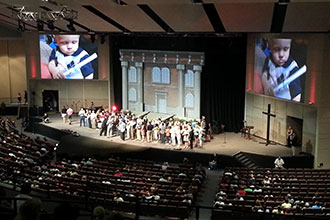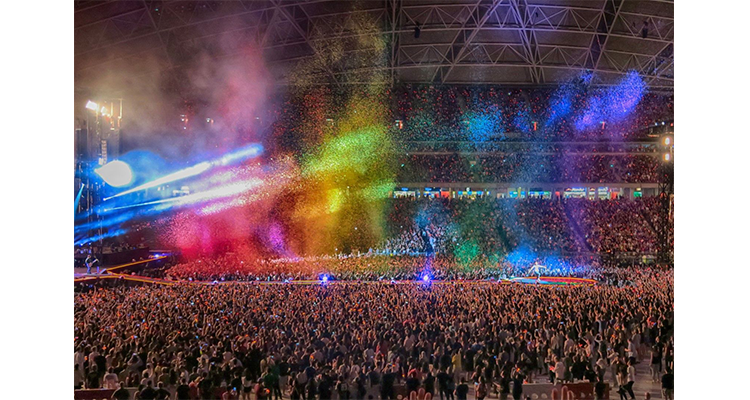Perfecting the AV Rental Balancing Act

Running a successful AV rental business has as many challenges as opportunities, from managing inventories to maximizing revenues. Fortunately, many of today’s projector manufacturers are focused on helping their customers achieve the right balance to keep them on the road to profitability.
Wayne Wagner, president and owner of Wagner Media and Scott Stremple, vice president sales – venues & hospitality, projection division, for Barco North America, discuss the critical success factors for today’s AV rental companies.
Flexibility Creates New Business
Wayne: Right now, we’re really excited about some of the new projectors featuring flexible light output. These offer a great way to extend our product line without stocking multiple models. As we all know, most jobs that call for projectors include a precise spec for lumens. If you don’t have a model that fits the requirement, then you’re out of the running. However, with the flex models, rental companies can customize the lumen output to meet the exact spec. For example, I can stock one of Barco’s 20K large venue projectors, which is great for the big, bright jobs — then dial down the light output for smaller projects and still be cost competitive with those offering straight 14K projectors. Next week, if that same or a new customer wants something else, I can adjust the light output anywhere from 10-20K. It’s like having six projectors in one!
Bottom line, we are bidding on more jobs now since we can meet the spec on a wider variety of projects and with fewer projectors on the shelf. As a result, we have the opportunity to price by the lumen instead of the projector when it makes sense.
Scott: Flexibility is the key to cost-effectively managing inventory over the long term. For example, most rental companies are built upon a grocery store model: Only so much shelf space is available and someone like Wayne needs to maximize the value of his inventory. With flexible light output projectors, a rental company can meet a wide variety of projection and lumens needs with fewer units. Less gear to stock, yet more options for customers — it’s a win-win.
Projector manufacturers have access to a host of new technologies like this which can make their products more versatile and economical for rental customers. Everyone is under margin challenges, and companies that help their customers become more profitable, will be the most successful over the long run.
At Barco, that’s our chief objective — to help our customers achieve the highest ROI possible on their projector investment. From “light on demand” capabilities to GSM functionality — which allows you to talk to your projector from any location in the world — it’s all about maximizing flexibility to increase not only revenues, but real profits.
Could Less Really be More?
Scott: One might argue that if a manufacturer increases the utility of its projectors, they will sell fewer projectors. Since we’re focused on helping our customers grow their businesses, we’re ok with that. It’s about creating opportunities for our partners to maintain a better cost structure, so they’re more profitable. They can also count on our products going the distance — we won’t sell you a model that you’ll have to replace in a year or two with a new and improved version. We’re investing in a technology platform that our customers can rely on for the long term. In turn, we would expect other forward-looking companies to follow suit and essentially level the playing field.
Wayne: A company like Barco is more likely to sell me an upgrade rather than a new projector and that’s great for keeping my total cost of ownership low. While a company like Barco may initially sell fewer projectors as the market transitions to this new “flex” concept, it makes sense for their customers’ long-term financial stability. The fact is, if I’m more profitable, I have more money to spend on projectors as I grow. And I’m more likely to buy from a manufacturer that has my best interests at heart.
Modularity Lowers Total Cost of Ownership
Scott: Typically, to meet the wide range of lumens needs of customers, rental companies would need to stock anywhere from 8-10 types of projectors. This can be headache for a rental company in terms of the extensive employee training, dozens of spare parts to inventory, and a myriad of lenses they need to stock. With a common projector platform, inventory and maintenance is greatly simplified. And, the commonality of parts and software, ease of use, and reduced training requirements all add up to a greater economies of scale.
Wayne: Anything I can do to simplify the operation and maintenance of the projectors is going to lower my total cost of ownership. Absolutely, modularity is paramount — in so many ways! It means I can employ a smaller staff who can become proficient on a few projectors instead of having to learn several models. With just a few spare parts, I can keep more of my stock operational and ready to rent at any given time, keeping inventory low and uptime high.
More Bang for the Buck
Wayne: When it comes to profitability, we’re finding that pricing “by the lumen” instead of “by the projector” can enhance our profitability. The benefit to the customer is they get a high-end projector at the lower lumen range, which means they get more bang for their buck. For example, when we customize the light output of our top-quality 20K projector to meet a 14K lumens requirement, our customer receives superior image quality, consistent lamp output and sophisticated image processing – things you don’t find in many other off-the-shelf 14K projectors. So they’re getting the light output they want and a whole lot more!
Scott: In certain circumstances, customers can enjoy the benefits of a technologically superior projector for a relatively low rental rate when choosing a flexible lumen model. The advantage to rental companies is that they have a more versatile and robust product line upon which to build an effective business model that works for them. It’s about achieving the right balance – leveraging your inventory to fulfill the widest array of customer needs while maximizing revenues.
Recapturing Lost Revenues
Wayne: One of the biggest benefits of some of the new smart projectors is the information they provide on usage. Projectors that log time and date of usage give me the information I need to invoice precisely according to actual usage. So there’s no guesswork or concern about letting out the unit early for an event. In the past, some customers would use it for extra hours if I did that and not report it – but now, I can bill for every hour used, which really means I’m capturing revenues which otherwise would have been lost.
Scott: Projectors like our flexible light output model give rental companies the data they need to stay on top of their inventory, ensure customer accountability, and effectively manage their rental fleet.
New Opportunities and Applications
Wayne: One of the good things about our industry is that the application “pie” continues to get bigger. 3D projection mapping is one of the new trends, but it’s not just outdoors any more. Churches are getting into the game, and theaters are using it for set design. We’ve been involved in a 3D projection mapping project for the Alley Theater in Houston, putting moving images on the floor and right on top of actors. There are so many creative possibilities beyond what can be accomplished with fabricated backdrops, like distorting and moving images to create a dream-like sequence, for example.
Scott: Yes, it’s no secret that 3D projection mapping is a huge growth area. It can provide a substantial cost savings in materials, labor, and time versus what it would take to create the hard sets for a movie set or play – and you can really look at different approaches to scene changes. The possibilities are only limited by the ability to imagine!
The Do’s and Don’ts of AV Rental
Wayne: When you look at the big picture and what it takes to be profitable as an AV rental company, there are a few basic things:
The Do’s
- Maintain positive cash flow. This is one of the toughest things in our business, but such an obvious one. We need to do a better job of collecting money. There’s a saying in our industry – “net never” terms – but we are starting to change this by being more focused on payment. At Wagner, we give very aggressive quick-pay discounts to incent our customers to pay quickly – 10/10 net 30. The newest projectors with built-in usage monitoring really go a long way toward improving accountability and accounts receivable.
- Get the best software. With the latest software, we now have the ability to do business via smartphones which really opens up opportunities for closing sales faster. Right now, I can send contracts to a customer’s cell phone and he can accept immediately – it’s completely legal and binding. With predictive software, we can also keep better control of inventory availability, accurately forecasting stock levels based on orders in all of our warehouses. The latest versions have better inventory tracking, which reduces the need to ship warehouse to warehouse, decreasing freight costs. With freight costs being one of the biggest obstacles to profitability, this is a tremendous benefit!
- Invest in modularity. Buy equipment that is modular with common parts so you can re-use components and accessories among models. It keeps both part costs and repair expenses low. And make sure to buy equipment with an upgrade path, which typically requires less investment over the long run.
The Don’ts
- Don’t have too many vendors. For the last 20 years, we’ve maintained a philosophy of having only a few vendors offering similar products. It pays to narrow your list and spend as much money as you can with one vendor for as many items as possible. You’ll become a valued dealer and get better pricing and availability with every order. Plus, you’ll know the products better – and if the manufacturer is smart, they’ll offer a product line with no gaps so you can buy everything you need from them.
- Don’t have too many employees. There are two parts to this: don’t have too many employees trying to learn too many projectors. It doesn’t behoove a rental company to hire all kinds of guys and then try to train them on a dozen different models. Like the sole source approach, you should have a few good employees who are really well trained on a few models. Then, they really know the gear instead of having to know too many models. In other words, keep it simple.
- Don’t turn away customers. Now, that seems obvious, but the opposite of this caveat is what you should strive for: always have a fast response time for both rental orders and service questions. With Barco’s “flex” line of projectors, we never have to say “we don’t have that,” or “I’ll get back to you.” Our answer needs to be “We have that, no problem,” and the light on demand capabilities of these projectors allow us to do just that, with the ability to tune the light output up or down to meet a customer’s needs.
Again, fewer projectors, more functionality equals happy customers (and more profits). It’s the perfect balance!





